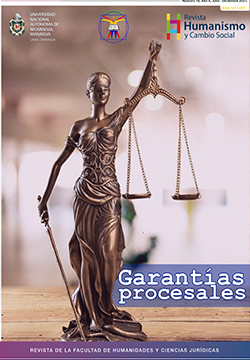Communication in the educational process, a look from Covid-19, a study carried out in the first year of medicine, FAREM-ESTELÍ, II semester 2020
DOI:
https://doi.org/10.5377/hcs.v17i17.13633Keywords:
Assertive communication, communicative and methodological strategies, meaningful learning, university environment and COVID-19 pandemicAbstract
Classroom communication is essential to developing the learning process and warrants that we review how we communicate in the classroom, outside the classroom, and during the COVID-19 pandemic. So, communicative strategies can be planned in the university setting and the academy cannot lag behind. This study focuses on the communicative strategies, accompanied by active methodological strategies that promote meaningful learning in the subject of Documentary Research Techniques, in the career of Medicine, of the Multidisciplinary Regional Faculty (FAREM), Estelí. The approach of this research is qualitative, descriptive, and cross-sectional, supported by the case study method. Data were obtained through the application of techniques such as documentary analysis, interview, focus group, survey, and observation. The study shows that communication was developed assertively, using different types of communication to empathize, motivate and capture the attention of the students. Interpersonal relationships were collaborative and affective, which allowed the conscious and meaningful appropriation of the contents. This contributed to the improvement of the learning process, verified in the verbal and gestural expressions and the production of articles. With this end, we provide a compilation of active methodologies, based on the types of communication, material for significant learning.
Downloads
References
Batista, M. (2018). Comunicación y medios masivos. México: Sin.
Bravo Benítez, M. (2006). Estrategias educativas en el aula. Málaga, Spain: Ediciones Aljibe. Recuperado de https://elibro.net/es/ereader/unanmanagua
Castillo, A. Ramírez, González, M. (2013) El aprendizaje significativo de la química: condiciones para lograrlo. Omnia, vol. 19, núm. 2, pp. 11-24. Universidad del Zulia Maracaibo, Venezuela.
Díaz J. (1976). Las nuevas pedagogías y tecnologías de comunicación. Ponencia presentada a la Reunión de Consulta sobre la Investigación para el Desarrollo Rural en Latinoamérica, Cali.
Dubios, J. (1998). Diccionario de Lingüística. Madrid: Alianza Editorial.
Gallego, D. (2013). Las concepciones de ciencia, metodología y enseñanza de los profesores en formación: el caso de la Facultad de Educación de la Universidad de Antioquia (Colombia) Doctoral dissertation). España:Universidad Internacional de Andalucía.
Giráldez, A. (2018). Comunicación en el aula I: ¿Importa lo que decimos? Recuperado de: https://www.educaciontrespuntocero.com/noticias/comunicacion-eficaz-aula/
González Castro, V. (1989). Profesión: Comunicador. La Habana: Pablo de la Torriente.
Gutiérrez, F y Prieto, D. (1996). Mediación Pedagógica. Guatemala: Instituto de Investigaciones y Mejoramiento Educativo, Universidad de San Carlos de Guatemala.
Hernández, R., Fernández, C. & Baptista, M. (2012). Metodología de la Investigación. México: McGRAW-HILL.
Hernández, R., Fernández, C. & Baptista, M., 2014). Metodología de la Investigación. México: McGRAW-HILL.
Juárez, M. (1992). Comunicación y Educación. Guatemala: Instituto de Investigaciones y Mejoramiento Educativo, Universidad de San Carlos de Guatemala. IIME-USAC.
Kaplun, M. (2002). Una pedagogía de la comunicación (el comunicador popular). La Habana, Cuba: Caminos
Longhi (2011). La comunicación en el aula. Colección de Cuadernillos de actualización para pensar la Enseñanza Universitaria, v. 6, n. 2. Recuperado de https://www.unrc.edu.ar/unrc/academica/
docs/publicaciones/cuadernillo-sep2011-6.pdf
López, F. (2007). Metodología Participativa en la Enseñanza Universitaria. Madrid: Narcea.
Martín Serrano, M. (1991). Teoría de la comunicación, Epistemología y Análisis de la referencia. México: UNAM-Acatlán.
Meza, M. (2018). El recurso de información y comunicación visual: imagen. e-Ciencias de la información, v. 8, n.2. Recuperado de https://dialnet.unirioja.es/servlet/articulo?codigo=6608012
Moreira, M. (2010) ¿Por Qué Conceptos? ¿Por Qué Aprendizaje Significativo? ¿Por Qué Actividades Colaborativas? y ¿Por Qué Mapas Conceptuales? Revista QURRICULUM. n. 21 Recuperado de https://riull.ull.es/xmlui/bitstream/handle/915/13338/Q_23_%282010%29_01.pdf?sequence=1&isAllowed=y
Moreira, M. (2012). La Teoría del Aprendizaje Significativo Crítico: un referente para organizar la enseñanza contemporánea. Revista IBEROAMERICANA DE EDUCACIÓN MATEMÁTICA, v. 5, n. 31 Recuperado de http://www.fisem.org/www/union/revistas/2012/31/archivo_5_de_volumen_31.pdf
Ojalvo, V. (1999). La educación como proceso de interacción y comunicación. Colectivo de Autores. U. H. - CEPES. Comunicación Educativa. La Habana.
Pimienta, J. (2012). Estrategias de enseñanza-aprendizaje. Docencia universitaria basada en competencias. México: PEARSON EDUCACIÓN
Portilla, M., Rojas, A. F., & Hernández, I. (2014). Investigación cualitativa: Una reflexión desde la educación como hecho social. Universitaria v. 3, n. 2 Recuperado de https://revistas.udenar.edu.co/index.php/duniversitaria/article/view/2192
Taylor, S.J & Bogdan (2001). Introducción a los métodos cualitativos de investigación. Argentina: Paidós.
Téllez, A.T. (2016). Estrategias metodológicas para el aprendizaje significativo de la Química. (Tesis doctoral). UNAN-Managua.
Saussure, F. (1961). Curso de Lingüística General. Buenos Aires: Losada.
UNAN-Managua. (2011). Modelo Educativo, Normativa y Metodología para la Planificación Curricular. Managua: Editorial Universitaria.
Watzlawick, P., Beavin, J., y Jackson, D. (2002). Teoría de la comunicación humana. Tiempo Contemporáneo: Buenos Aires.
Zayas Agüero, P. M. (2012). La comunicación interpersonal. Málaga, Argentina: B - EUMED. Recuperado d e h ttps://elibro.net/es/ereader/unanmanagua/51694?page=120.
Downloads
Published
How to Cite
Issue
Section
License
Copyright (c) 2021 Universidad Nacional Autónoma de Nicaragua, UNAN-Managua

This work is licensed under a Creative Commons Attribution-NonCommercial-ShareAlike 4.0 International License.




